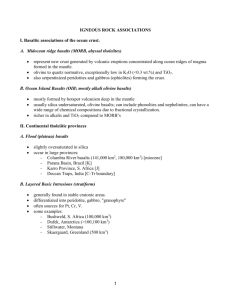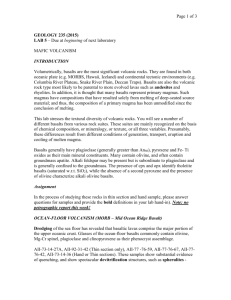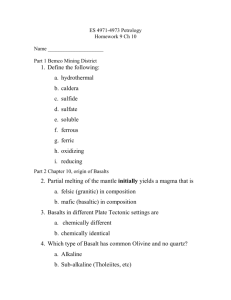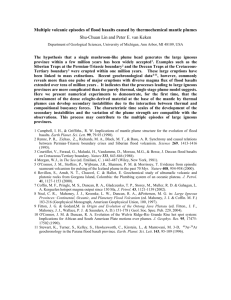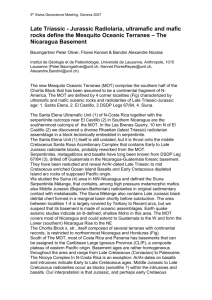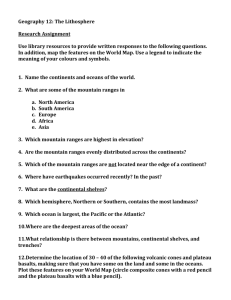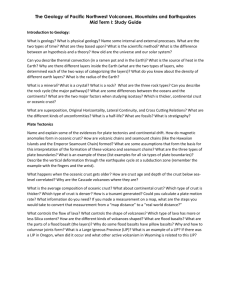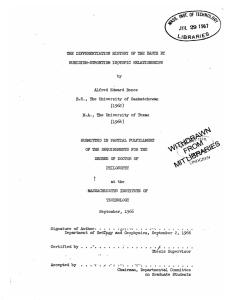Extended Abstract IPPP event
advertisement
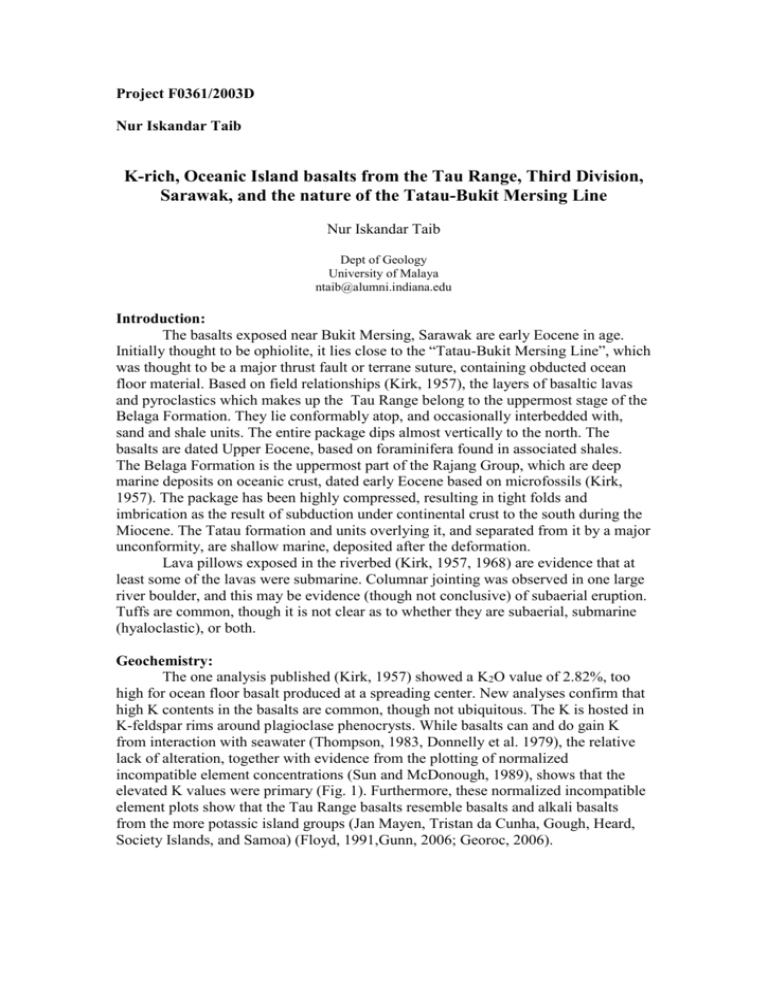
Project F0361/2003D Nur Iskandar Taib K-rich, Oceanic Island basalts from the Tau Range, Third Division, Sarawak, and the nature of the Tatau-Bukit Mersing Line Nur Iskandar Taib Dept of Geology University of Malaya ntaib@alumni.indiana.edu Introduction: The basalts exposed near Bukit Mersing, Sarawak are early Eocene in age. Initially thought to be ophiolite, it lies close to the “Tatau-Bukit Mersing Line”, which was thought to be a major thrust fault or terrane suture, containing obducted ocean floor material. Based on field relationships (Kirk, 1957), the layers of basaltic lavas and pyroclastics which makes up the Tau Range belong to the uppermost stage of the Belaga Formation. They lie conformably atop, and occasionally interbedded with, sand and shale units. The entire package dips almost vertically to the north. The basalts are dated Upper Eocene, based on foraminifera found in associated shales. The Belaga Formation is the uppermost part of the Rajang Group, which are deep marine deposits on oceanic crust, dated early Eocene based on microfossils (Kirk, 1957). The package has been highly compressed, resulting in tight folds and imbrication as the result of subduction under continental crust to the south during the Miocene. The Tatau formation and units overlying it, and separated from it by a major unconformity, are shallow marine, deposited after the deformation. Lava pillows exposed in the riverbed (Kirk, 1957, 1968) are evidence that at least some of the lavas were submarine. Columnar jointing was observed in one large river boulder, and this may be evidence (though not conclusive) of subaerial eruption. Tuffs are common, though it is not clear as to whether they are subaerial, submarine (hyaloclastic), or both. Geochemistry: The one analysis published (Kirk, 1957) showed a K2O value of 2.82%, too high for ocean floor basalt produced at a spreading center. New analyses confirm that high K contents in the basalts are common, though not ubiquitous. The K is hosted in K-feldspar rims around plagioclase phenocrysts. While basalts can and do gain K from interaction with seawater (Thompson, 1983, Donnelly et al. 1979), the relative lack of alteration, together with evidence from the plotting of normalized incompatible element concentrations (Sun and McDonough, 1989), shows that the elevated K values were primary (Fig. 1). Furthermore, these normalized incompatible element plots show that the Tau Range basalts resemble basalts and alkali basalts from the more potassic island groups (Jan Mayen, Tristan da Cunha, Gough, Heard, Society Islands, and Samoa) (Floyd, 1991,Gunn, 2006; Georoc, 2006). Figure 1: Incompatible trace element concentrations, normalized to mantle Based on the chemistry, and on field relationships, the Tau Range basalt is not ophiolite, but is likely to be Oceanic Island basalt, developed over oceanic crust, caused by short-lived hot spot magmatism. That the basalts are conformable with the underlying Belaga Formation metasediments means that they were deposited on top of the sediments covering the oceanic basement, rather than being themselves part of that basement. The Belaga Formation continues below the Tatau formation, and is exposed as the Tatau “Horst”, to the north. This implies that the Tatau-Bukit Mersing line is not a terrane suture, and is, rather, a regional unconformity between deep water (Belaga Formation) and slightly later shallow water (Tatau Formation) sediments (Hutchison, 2005). References Donelly, T.W., Thompson, G., and Salisbury, M.H., 1979. The chemistry of altered basalts at Site 417, Deep Sea Drilling Project Leg 51. In: Donelly, T., Francheteau, J., Bryan, W.B., Robinson, P.T., Flower, M., Salisbury, M., et al. (eds.) Initial reports of the Deep Sea Drilling Project, 51,52,53. pp. 13191330. Floyd, P., 1991. Oceanic islands and seamounts. In Floyd, P., 1991 (ed) Oceanic Basalts. Blackie and Sons, Glasgow and London. Chapter 9, pp. 174-218 Georoc, 2006. GEOROC – Geochemistry of rocks of the oceans and continents. http://georoc.mpch-mainz.gwdg.de/georoc/, accessed 5th April, 2006. Max Planck Gesellschaft. Gunn, B.M., 2006. Geochemistry of igneous rocks. http://www.geokem.com, accessed 5th April, 2006. Hutchison, C.S. 2005. Geology of North-West Borneo – Sarawak, Brunei and Sabah. Elsevier, 421 pp. Kirk, H. J. C., 1957. The geology and mineral resources of the Upper Rajang and adjacent areas. Brit. Territ. Borneo Geol. Surv. Memoir 8. Kirk, H. J. C., 1968. The igneous rocks of Sarawak and Sabah. Geol. Surv. Borneo Region Malaysia Bull. 5. Sun, S.S., and McDonough, W.F. (1989) Chemical and isotopic systematics of ocean basalts: implications for mantle composition and processes. In: Saunders, A.D. and Norry, M.J. (eds) Magmatism in the Ocean Basins, Geol. Soc. London Spec. Publ. 42, pp. 313-345. Thompson, G., 1983. Hydrothermal fluxes in the ocean. In: Riley, J.P., and Chester, R. (eds) Chemical Oceanography (vol. 8), Academic Press, London, pp. 271-337. Wolfenden, E. B., 1960. The Geology and mineral resources of the Lower Rajang valley and adjoining areas, Sarawak. Brit. Borneo Geol. Surv. Mem. 11.
